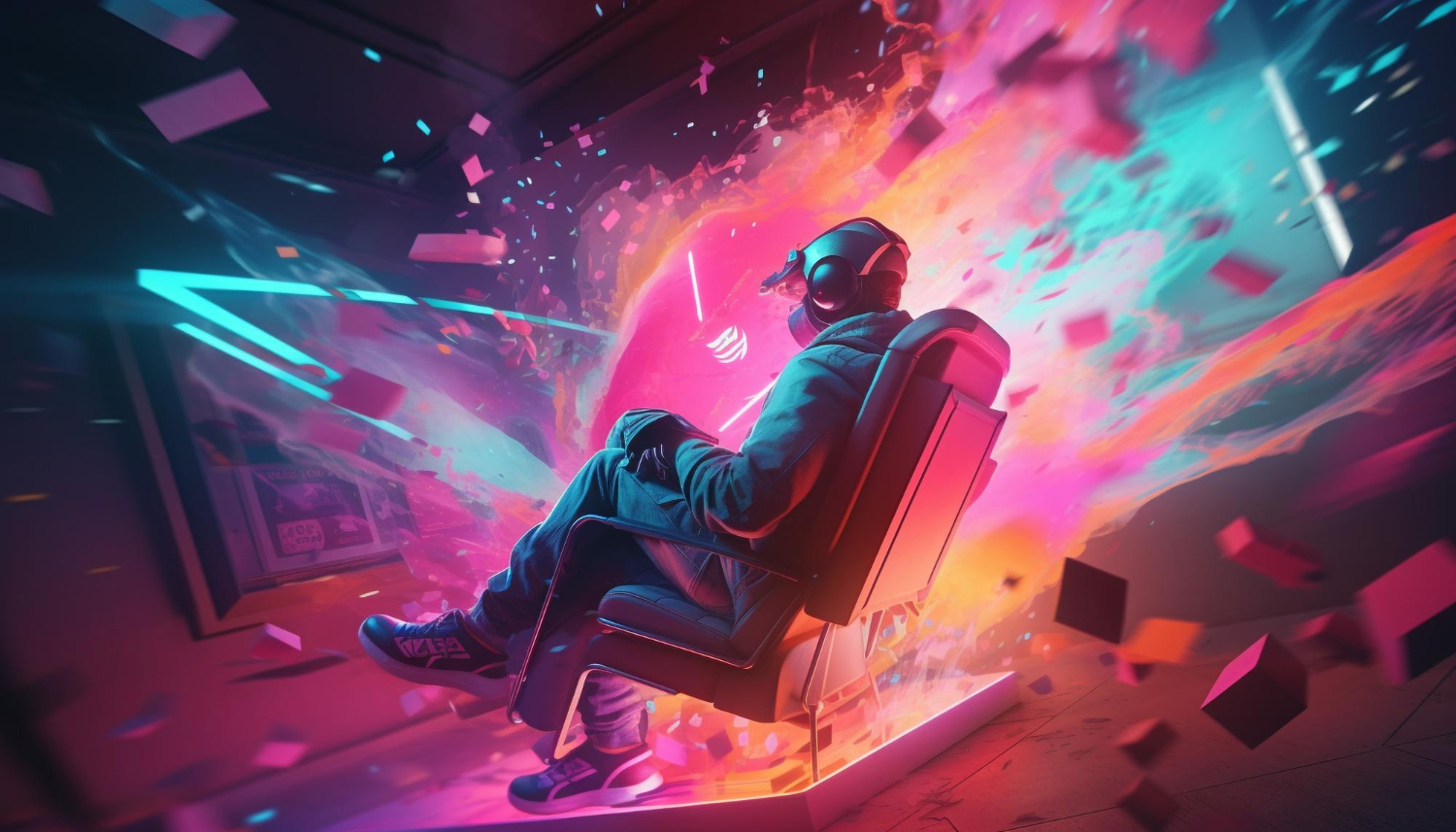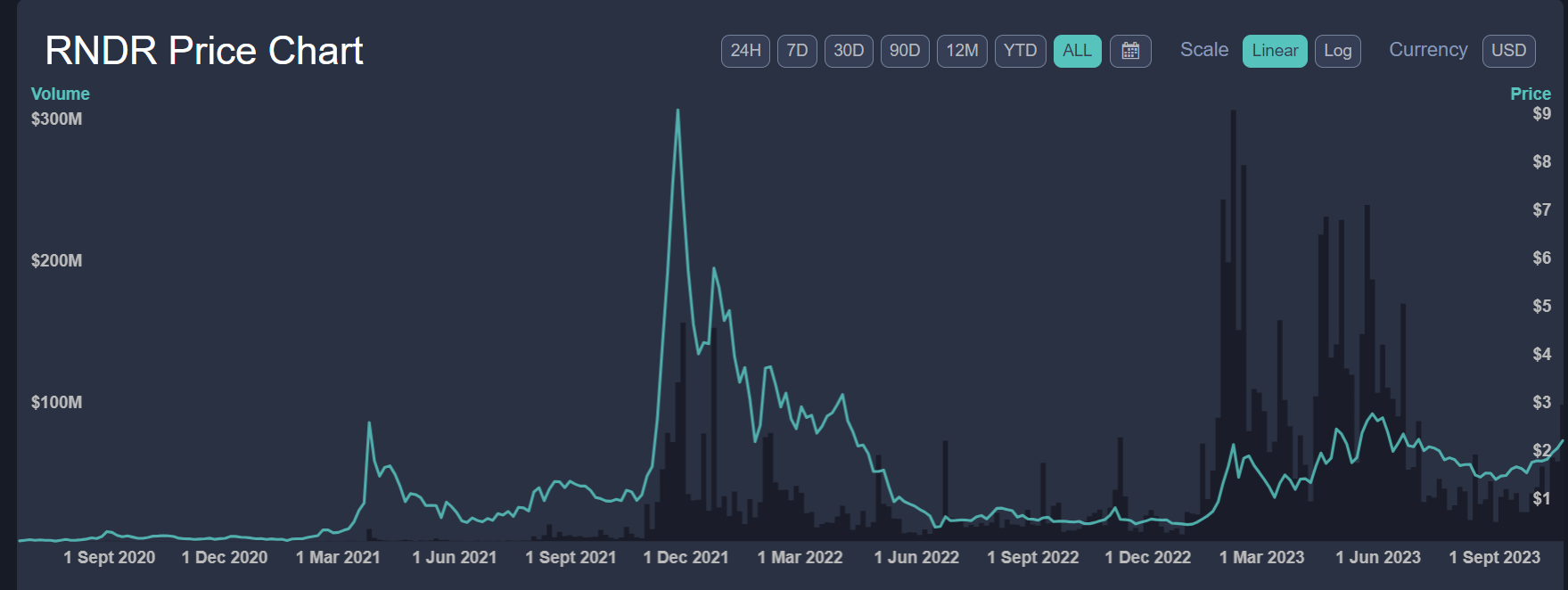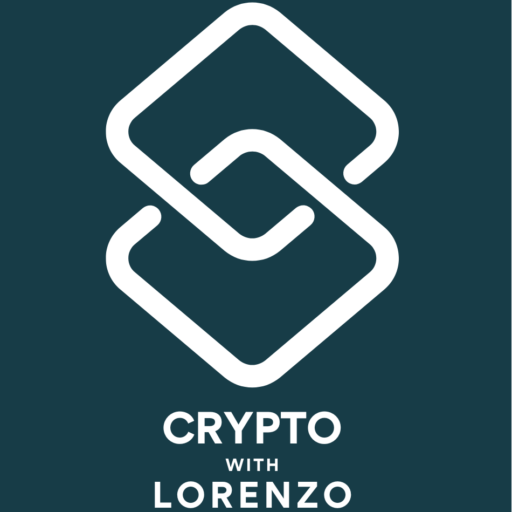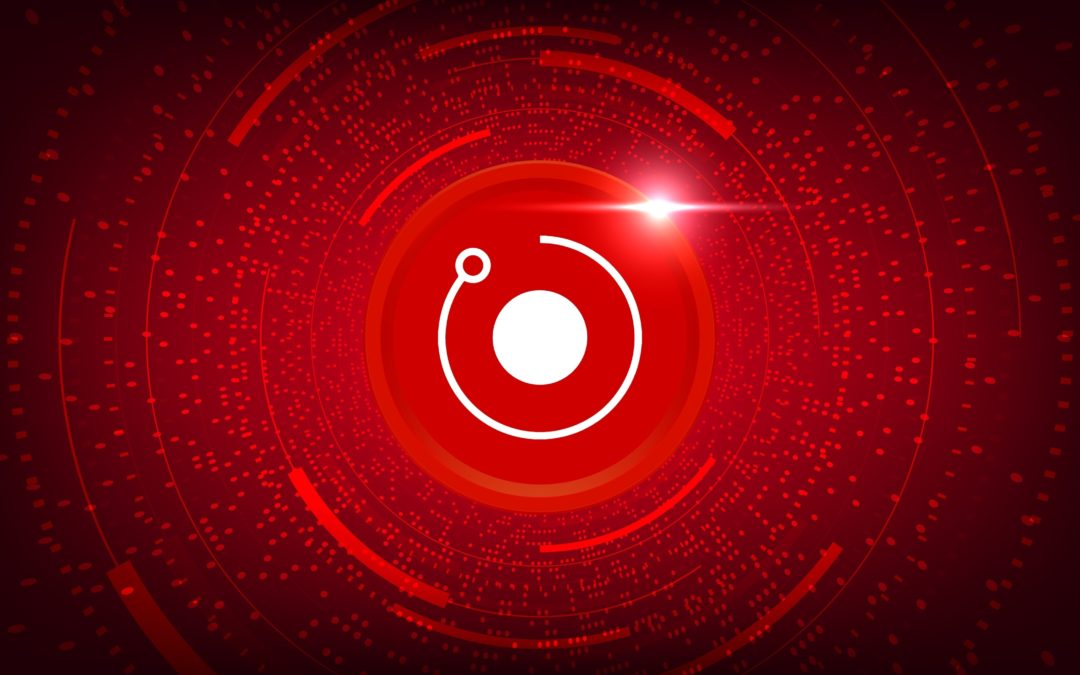As one of the best-performing crypto assets in 2023, is a new all-time high on the horizon?
With ongoing technological improvements and greater processing power comes the expectation of more advanced graphics across various media, particularly for gaming.
On top of this, graphics rendering will become increasingly important with the advent of the metaverse, growth in VR/AR, improved frame rates (and general display specs) and faster average Internet speeds, living in an increasingly digital world…for better or worse.
Rendering complex images comes with cost and energy limitations, leading to an increasing need for cloud-based rendering as an alternative to on-site render farms.
These cloud-based services can be very costly despite the convenience of remotely accessing the required processing power.
This is where Render Network (RN) comes in, with its vision to democratise access to processing power through blockchain technology.
There is a competition for resources within the centralized GPU cloud – from GPU rendering and cloud streaming to AI training – leading to availability constraints and prohibitively expensive pricing for many artists.
What is rendering, and what’s RN’s role in this?
This is the important step in image and video editing, taking all the lighting, colours, shades and positions of characters in a frame and linking them to create amazing images and videos we see through video games and films, with Pixar movies as a prime example.
With hundreds of layers involved in creating these spectacularly rendered images comes an enormous amount of computing power (let alone time and expertise) required to carry out the entire process.
This is where RN and its token, RNDR, are involved.
RN is building its system that allows individuals to offer excess GPU power to the protocol others can purchase, i.e., a type of GPU power crowdsourcing. The network uses a governance system called Proof-of-Rendering (PoR), with a great overview available here.
This project is the brainchild of Jules Urbach, the CEO, Co-founder and Chairman of OTOY, a cloud graphics company established in 2008 and based in Los Angeles, CA.
This (RN) is a great use of the blockchain and everyone’s GPU power…our vision is to democratize compute and rendering power.
Does some of this sound familiar? I’ve previously covered Filecoin, a project working on a similar system, but one that focuses on using available HDD/SDD storage space on your computer instead of delegating GPU power.
These are excellent concepts to take advantage of otherwise underutilised space and reward those participating in the project.
https://medium.com/crypto-insights-au/crypto-watch-april-2023-filecoin-fil-2f3c5ad44646
On this note, one of the RN advisors is David Vorick, the CEO and Co-founder of Sia, a competitor to Filecoin. It will be interesting to see what collaborations could arise between the two, how this will impact Siacoin (SC), and whether the crypto can return to its all-time high (ATH) set in January 2018.
I am not holding my breath, but let’s see what happens with SC and RNDR.
RNDR is the leading crypto asset primarily focused on shared computing (GPU) power for rendering, converting 3D images into highly detailed 2D images to display on a screen.

Image by vecstock on Freepik
RNDR tokenomics
The token is currently ranked 48th in terms of circulating market cap.
For perspective, most assets in the top 100 are down so far this year, so RNDR bucking the trend makes people even more bullish about this token and the network.
As I touched on earlier, RNDR has outperformed multiple crypto assets in 2023, generating an ROI of 331% year-to-date (YTD). This is several times more than rival projects such as Ankr Network (ANKR) and Golem (GLM).

Source: LiveCoinWatch. Snapsnot taken on 26 October 2023.
Two promising signs for RNDR’s price going into 2024 are the strong growth in the token’s 24-hour trading volume (as denoted by the black column graph) and a price recovery since the beginning of 2023.
News and partnerships
Apple x OctaneRender®
Render Network is one of many products offered by OTOY. One of its renowned tools is OctaneRender®, which the company describes as “the world’s first and fastest unbiased, spectrally correct GPU render engine”. This, and the Ethereum blockchain, are what powers the RN.
Last year, OTOY partnered with Apple to launch this service on Mac computers and iPads via the Octane X app.
RN expanding to Solana?
In recent months, a major talking point for this project has been the proposal to move RN from its current token contract (on Ethereum) to Solana’s blockchain.
This ties into the community vote in favour of a Burn and Mint Equilibrium (BME) – check out RN’s whitepaper on page 10 for a clear and concise explanation – and relates to the expansion of Render Network to other networks.
Solana appears to be the most likely option for network expansion, with RN referring to Rust – a programming language used for its blockchain – being more suitable than Solidity, which is used for Ethereum.
Rust can provide the Render Network greater speed and flexibility than Solidity, ultimately permitting the use of the same code for GPU render work and smart contracts.
Render Network blog post, March 21, 2023.
12-18 months ago, I would have been reluctant to run dapps on Solana due to its spate of network outages in 2021 and 2022. However, to its credit, it has significantly improved its uptime as of late and has taken steps to further decentralise its network, but it still has a way to go.
___________________________________________________________________________
In 2021, OTOY announced Mike Winkelmann (a.k.a. Beeple) will be joining its and RN’s advisory boards to influence their future strategies and approaches to digital art and technology.
For those of you who aren’t familiar with Beeple, he took the world by storm during the NFT mania in 2021, when his project – a collage of smaller artworks, 5,000 days in the making – sold for an astronomical $69.3 million through a Christie’s auction.
5,000 days à 13.5 years. Now, that’s perseverance.
His presence on these advisory boards should serve as strong publicity for OTOY and RN, particularly when the crypto market picks up once again. With that will also come the renewed interest in digital collectibles, virtual art, fractionalised ownership of these items and more.
There is the added benefit of producing, purchasing and interacting with these (digital) collector’s items in cheaper and generally more efficient ways, particularly as blockchains and dapps continuously improve.
__________________________________________________________________________
Last but not least, here’s one for any metaverse enthusiasts.
In a 2018 article, OTOY announced it’s teaming up with Decentraland, a blockchain-based, decentralised gaming and metaverse platform.
This will allow users to connect with RN’s GPU network to help create assets on Decentraland, which is particularly useful for more complex GPU rendering tasks requiring additional processing power. Going via RN makes sharing a finished product with others on a peer-to-peer network easier.
RNDR details and a new ATH imminent?
The token is currently at ~$2.13, and with a market cap of ~$790 million, it is down by ~80% from its ATH of $8.76, set in November 2021. It has a circulating supply of 371.9 million RNDR, with roughly ~531 million tokens for its total supply.
While past performance does not guarantee future results, I predict massive potential with this token, especially with the anticipated GPU sharing and image rendering growth in the coming years. This is particularly the case with far more advanced image and video production as part of the metaverse, augmented reality, gaming, VR and other industries.
If I were to take a stab in the dark, I expect RNDR to eclipse its ATH in the next 12-15 months. I imagine it will benefit significantly from the hype in the lead-up to the 2024 Bitcoin Block Reward Halving more than actual adoption. However, I expect the latter to play a role in aiding the altcoin’s rise to(wards) its current all-time high.
A bullish signal as of late is the vast amount of RNDR off exchanges and into non-custodial wallets, with whales (i.e., those with individual wallets containing between 100K and 10M tokens) snapping up over $24 million of RNDR in two days, as shown in the following tweet.
📈 The team at @rendernetwork has been rendering some substantial profits for investors & traders here in October. There has been a major accumulation of $24.1M from wallets holding 100K-10M $RNDR, coinciding with a large movement of coins off exchanges. https://t.co/36GSUkLeN5 pic.twitter.com/A07EHFP6Oz
— Santiment (@santimentfeed) October 16, 2023
Source: Santiment on X (Twitter)
Additional thoughts
Decentralised GPU power will become increasingly important in future, particularly with the increased demands for this computing power for AI startups – especially with chip shortages in recent times – and more advanced graphics over time due to technological improvements, i.e., Moore’s Law and GPU performance.
A distributed GPU network will eventually play a pivotal role in helping meet this rapidly growing need for graphics power, whether this involves RN or another protocol as the dominant player.
On this note, competition is fierce. While Render Token is one of the dominant players in the decentralised GPU rendering space, we must always be mindful of competition and how RN and established (centralised) cloud-rendering services adapt accordingly.
I touched on Siacoin earlier. Golem Network has been an active player in this space since 2015 (albeit not as prominent as it once was). Ankr – which has partnered with Microsoft – is another digital asset to watch; potential competition for this subset of GPU rendering.
In terms of the latter, these well-established companies in the space – Amazon Web Services, Microsoft Azure, NVIDIA DGX and other established entities could also create their decentralised projects (even if they’re semi-decentralised) or even partner with an RN competitor.
I expect a situation in future where we have enough demand for both centralised and decentralised systems.
Why? There will still be a cohort of society that is reluctant to support one of these new protocols, such as RN, in part due to negative perceptions/misunderstandings of blockchain technology, e.g., criminals use it, and they’re likely to get hacked (this is highly variable, depending on the protocol and base chain used).
A common example is with people who decide to hold large amounts of cash in a bank due to the perceived trust and brand reputation these financial institutions have built over decades/centuries, even if more profitable and newer alternatives exist (e.g. BTC, certain stocks, etc.).
However, this will change once Render Token (or a similar provider) becomes mainstream, and enough people trust it to be a superior alternative, a matter of when not if.
Ways to stay in the loop with Render Token
– Official website
– Whitepaper
– X (Twitter)
– Medium blog
– Render Network Foundation
– Discord
– Reddit
– Telegram
– Render Token GitHub repositories
– Render Network knowledge base
– OTOY website
Please double-check the veracity of all these websites before interacting with anyone featured on these Render/RNDR pages and channels. I rarely use Reddit and Telegram, so I am going off what appear to be legitimate sources.
Additional resources
– Coin Bureau, one of the leading resources for cryptocurrency and blockchain content, offers their thoughts on RN in this comprehensive review, with a neat pros and cons summary.
– The network’s roadmap is another useful resource to help the community and prospective RNDR investors gauge what has been achieved and what is in the work. This is a community-led document, so that you can add to it.
– Check out this video from DigiDigger on YouTube, ‘How do games render their scenes?’. I also recommend his video about more advanced graphic-rendering methods in a related video, ‘How does ray tracing produce hyper realistic graphics?’. The latter gives further insight into how gaming developers plan to overcome shortcomings with current rendering techniques.
Disclaimers
None of this is financial advice; I am not a financial advisor.
The opinions expressed within this piece are my own and might not reflect those behind Protocol Labs, Render Token Foundation or any other organisation associated with Render Token.
Please do sufficient research before investing in any crypto assets, staking, NFTs and other products affiliated with this space.
I hold a small amount of RNDR, accounting for less than 1% of my total crypto portfolio. I also have a similar amount of Golem (GLM).
If you enjoyed this article, I recommend following my Medium page for regular reports about crypto assets, blockchain technology, and more. Feel free to check out my publication as well, Crypto Insights AU.
Thanks for your support.
Featured image by WindAwake on Shutterstock.

